NASA

Astronomy Picture of the Day
This is NASA Astronomy Picture of the Day and a collection of 10 random APODs.
Today's picture
Giant Galaxies in Pavo
2025-08-19
Over 500,000 light years across, NGC 6872 (bottom left) is a truly enormous barred spiral galaxy. At least 5 times the size of our own large Milky Way, NGC 6872 is the largest known spiral galaxy. About 200 million light-years distant toward the southern constellation Pavo, the Peacock, the appearance of this giant galaxy's stretched out spiral arms suggest the wings of a giant bird. So its popular moniker is the Condor galaxy. Lined with massive young, bluish star clusters and star-forming regions, the extended and distorted spiral arms are due to NGC 6872's past gravitational interactions with the nearby smaller galaxy IC 4970, visible here below the giant spiral galaxy's core. Other members of the southern Pavo galaxy group are scattered through this magnificent galaxy group portrait, with the dominant giant elliptical galaxy, NGC 6876, above and right of the soaring Condor galaxy.
10 Random APODs
Inverted City Beneath Clouds
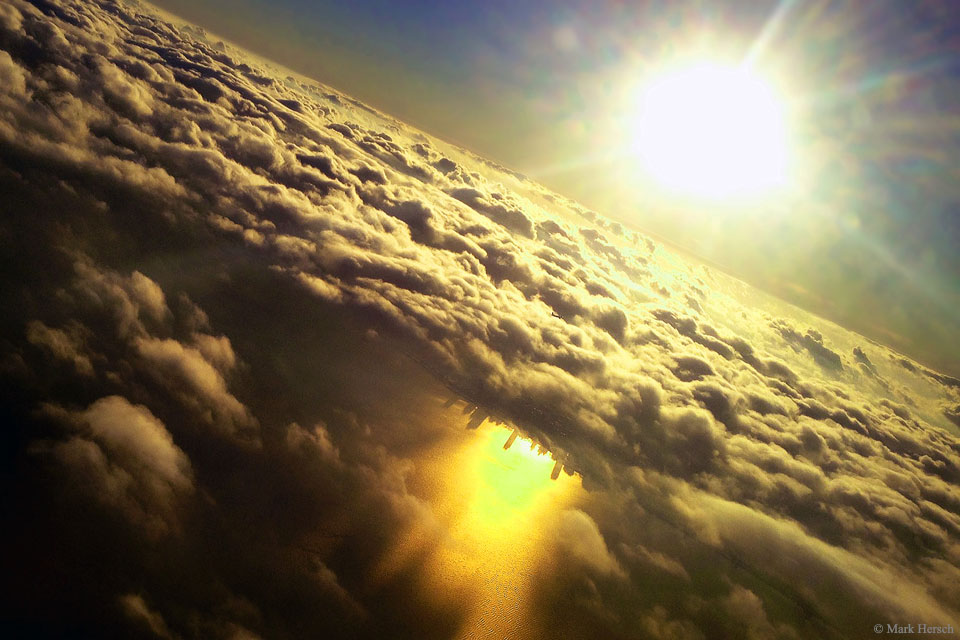
Mark Hersch
2020-06-24
How could that city be upside-down? The city, Chicago, was actually perfectly right-side up. The long shadows it projected onto nearby Lake Michigan near sunset, however, when seen in reflection, made the buildings appear inverted. This fascinating, puzzling, yet beautiful image was captured by a photographer in 2014 on an airplane on approach to Chicago's O'Hare International Airport. The Sun can be seen both above and below the cloud deck, with the latter reflected in the calm lake. As a bonus, if you look really closely -- and this is quite a challenge -- you can find another airplane in the image, likely also on approach to the same airport.
Four X-class Flares
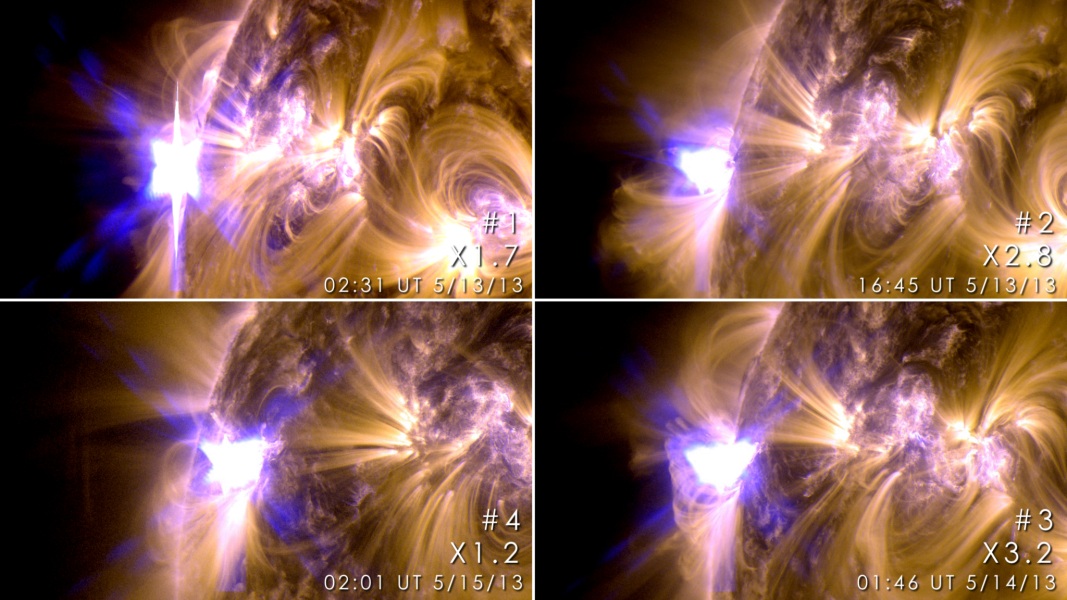
2013-05-16
Swinging around the Sun's eastern limb on Monday, a group of sunspots labeled active region AR1748 has produced the first four X-class solar flares of 2013 in less than 48 hours. In time sequence clockwise from the top left, flashes from the four were captured in extreme ultraviolet images from the Solar Dynamics Observatory. Ranked according to their peak brightness in X-rays, X-class flares are the most powerful class and are frequently accompanied by coronal mass ejections (CMEs), massive clouds of high energy plasma launched into space. But CMEs from the first three flares were not Earth-directed, while one associated with the fourth flare may deliver a glancing blow to the Earth's magnetic field on May 18. Also causing temporary radio blackouts, AR1748 is likely not finished. Still forecast to have a significant chance of producing strong flares, the active region is rotating into more direct view across the Sun's nearside.
Sunset, Moonset, Taj Mahal
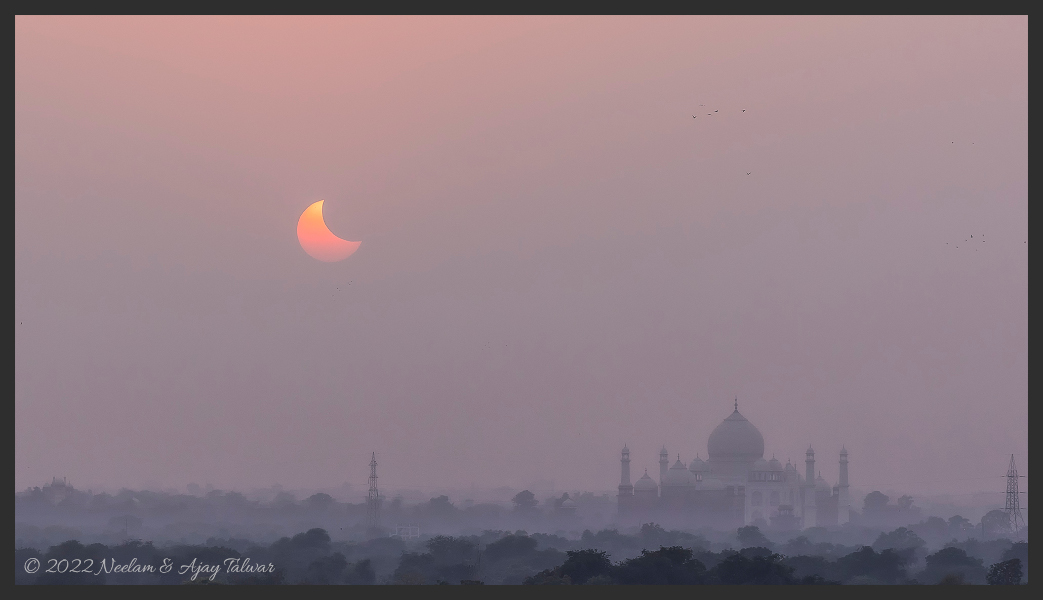
Neelam and Ajay Talwar
2022-10-27
On October 25th, Sun and New Moon set together as seen from Agra, India. Their close conjunction near the western horizon, a partial solar eclipse, was captured in this elevated view in hazy skies near the solitary dome of the Taj Mahal. Of course, the partial solar eclipse was also seen from most of Europe, northern Africa, the Middle East, and western parts of Asia. This eclipse was the last of two solar eclipses (both partial eclipses) in 2022. But the next Full Moon will slide through planet Earth's shadow on November 7/8, in a total lunar eclipse.
Orion's Belt and Sword over Teide's Peak
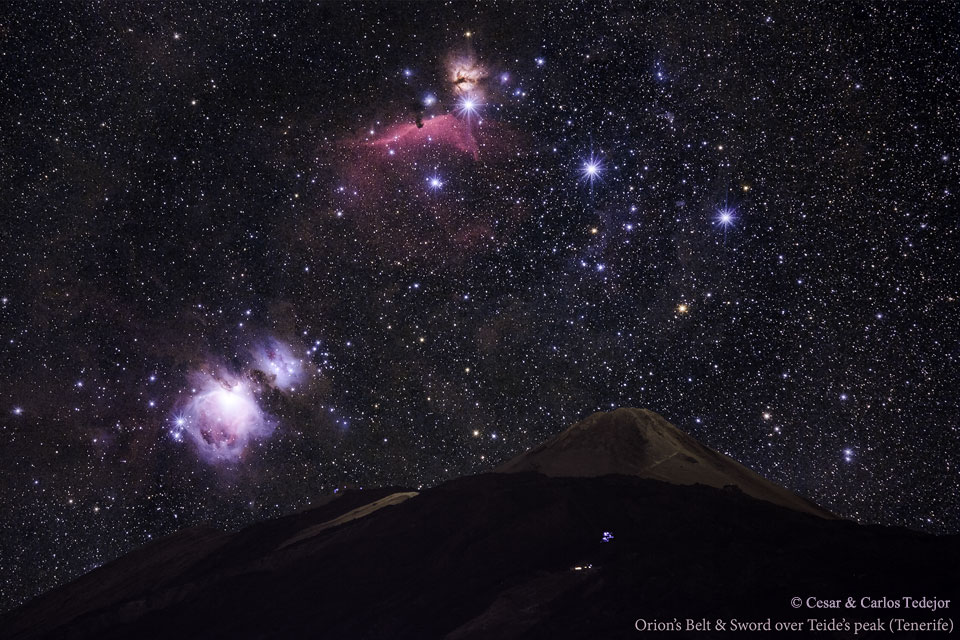
Cesar & Carlos Tejedor
2016-03-28
The southern part of Orion, the famous constellation and mythical hunter, appears quite picturesque posing here over a famous volcano. Located in the Canary Islands off the northwest coast of Africa, the snow-peaked Teide is one of the largest volcanoes on Earth. Lights from a group planning to summit Teide before dawn are visible below the volcano's peak. In this composite of exposures taken from the same location one night last month, the three iconic belt stars of Orion are seen just above the peak, while the famous Orion Nebula and the rest of Orion's sword are visible beyond the volcano's left slope. Also visible in the long duration sky image are the Horsehead Nebula, seen as a dark indentation on the red emission nebula to the belt's left, and the Flame Nebula, evident just above and to the right of the Horsehead.
IC 2944: The Running Chicken Nebula
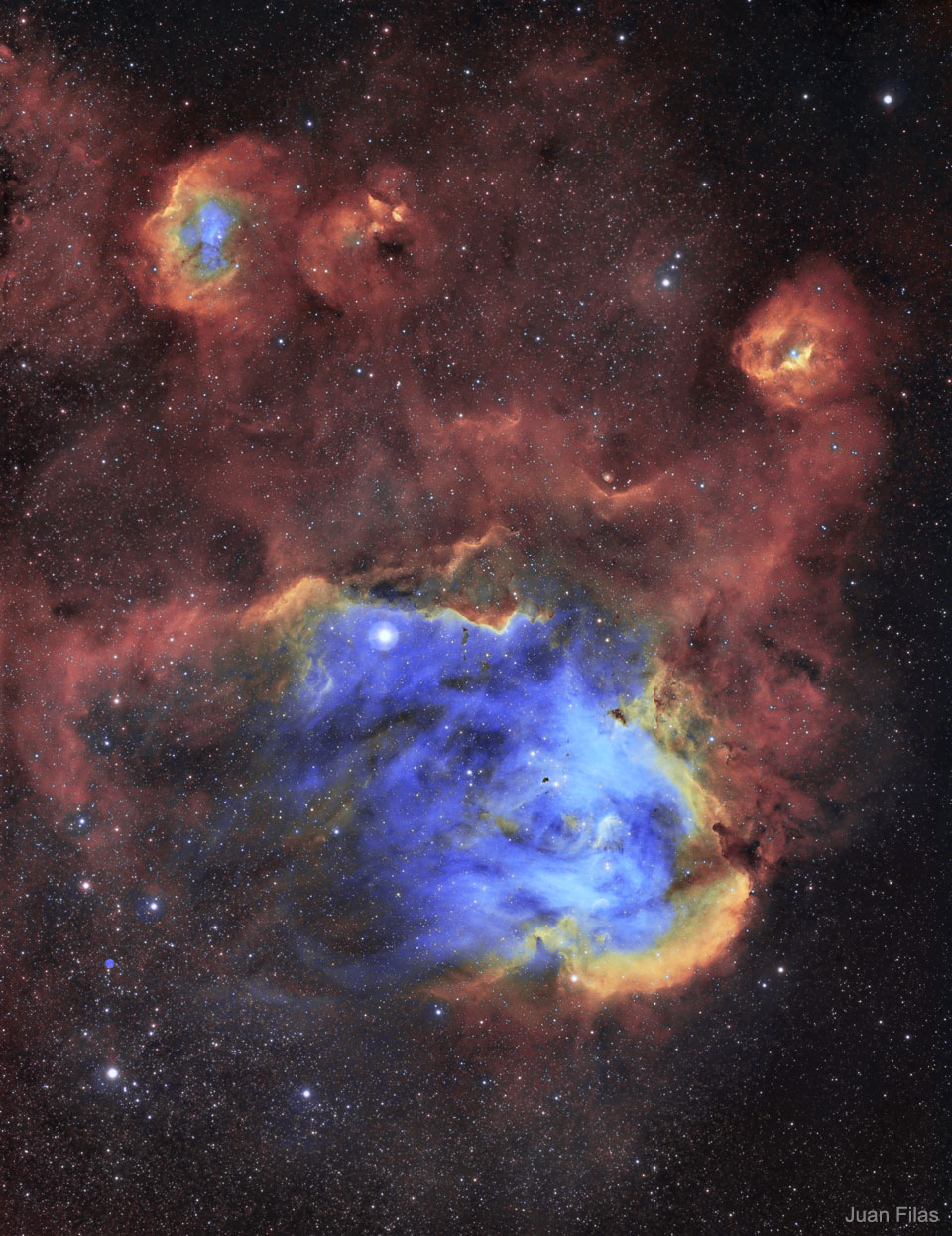
Juan Filas
2020-04-20
To some, it looks like a giant chicken running across the sky. To others, it looks like a gaseous nebula where star formation takes place. Cataloged as IC 2944, the Running Chicken Nebula spans about 100 light years and lies about 6,000 light years away toward the constellation of the Centaur (Centaurus). The featured image, shown in scientifically assigned colors, was captured recently in a 12-hour exposure. The star cluster Collinder 249 is visible embedded in the nebula's glowing gas. Although difficult to discern here, several dark molecular clouds with distinct shapes can be found inside the nebula.
Night-Shining Clouds
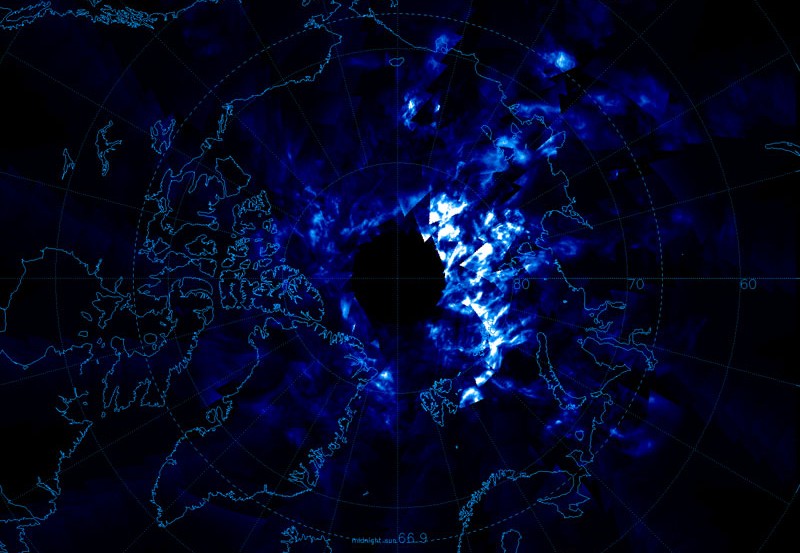
2007-07-05
Alluring noctilucent or night-shining clouds lie near the edge of space, some 80 kilometers above Earth's surface. Of course, when viewed from space the clouds are more properly called polar mesospheric clouds (PMCs) -- seen here for the first time in image data from the Aeronomy of Ice in the Mesosphere (AIM) satellite. The clouds form over the poles in the corresponding summer season and are now being seen more frequently at lower latitudes. This paticular view from June 11 details the PMC structures forming over the north polar region in white and blue. (Black indicates no cloud data was available.) The AIM satellite should be able to track two complete cloud seasons over both poles to investigate possible connections between the high altitude night-shining clouds and global change in the lower atmosphere.
The North Pole Of Mars
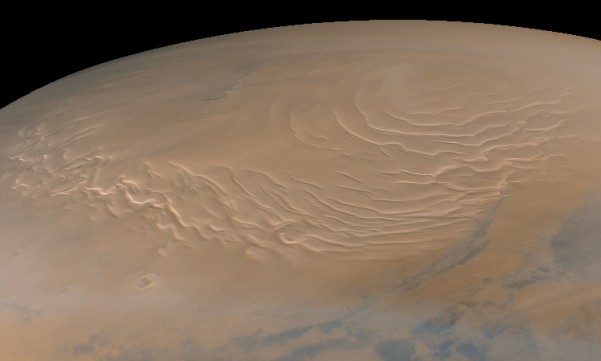
1998-09-24
The North Pole of Mars is capped by layers likely consisting of ice and dust deposited over millions of years. Imaged on September 12 - early Spring for Northern Mars - by the Mars Global Surveyor's camera, this synthesized wide-angle color view shows the rippled, eroded polar terrain covered with pinkish seasonal carbon dioxide frost. Dark areas bordering the polar cap are fields of sand dunes. This is the last picture scheduled to be taken by Surveyor's camera until it resumes operation in late March 1999. Over the past year of operation, the camera has taken about 2,000 pictures of Mars. Meanwhile, the spacecraft will begin its second round of aerobraking to achieve a circularized martian mapping orbit.
North Pole Below
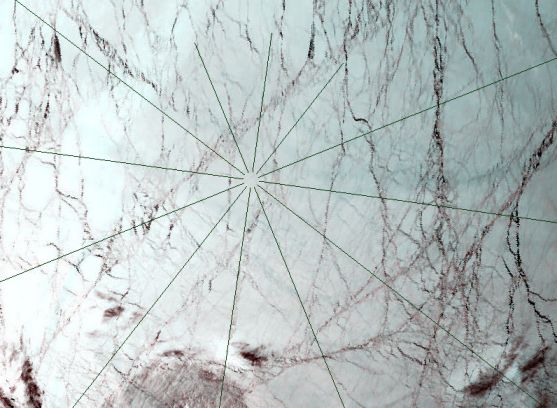
2000-10-20
Orbiting over the north pole of planet Earth on May 5, the MODIS instrument on-board the Terra spacecraft, recorded this view of the ice cap 700 kilometers below. A radial grid centered on the pole is shown on top of the approximately true color image where each pixel covers about one square kilometer. Frozen sea ice appears whitish while open water or newly refrozen ice looks black. An impressive criss-crossing network of cracks in ice shifting above a liquid water ocean is visible, traced by the meandering dark lines. In fact, the dark network of cracks in the sea ice is reminiscent of another world in our solar system which may also harbor a liquid water ocean -- Jupiter's ice moon Europa.
Portrait of NGC 3628
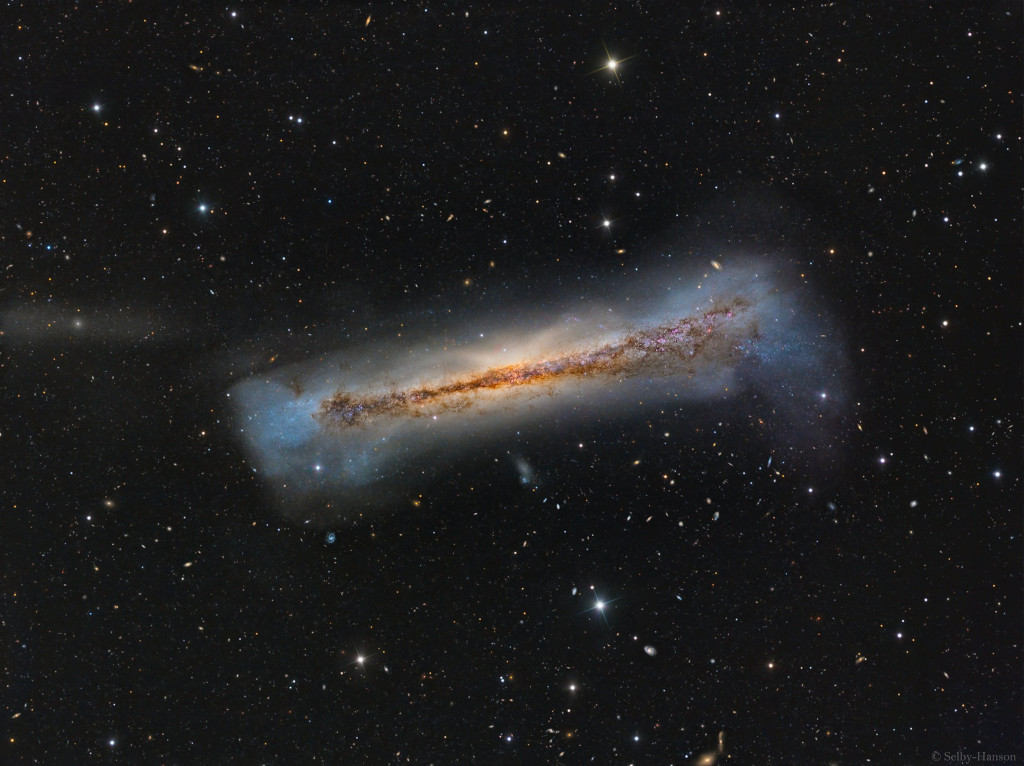
Mike Selby
2023-04-14
Sharp telescopic views of NGC 3628 show a puffy galactic disk divided by dark dust lanes. Of course, this portrait of the magnificent, edge-on spiral galaxy puts some astronomers in mind of its popular moniker, the Hamburger Galaxy. It also reveals a small galaxy nearby (below), likely a satellite of NGC 3628, and a very faint but extensive tidal tail. The drawn out tail stretches for about 300,000 light-years, even beyond the left edge of the frame. NGC 3628 shares its neighborhood in the local universe with two other large spirals M65 and M66 in a grouping otherwise known as the Leo Triplet. Gravitational interactions with its cosmic neighbors are likely responsible for creating the tidal tail, as well as the extended flare and warp of this spiral's disk. The tantalizing island universe itself is about 100,000 light-years across and 35 million light-years away in the northern springtime constellation Leo.
Andromeda over the Alps
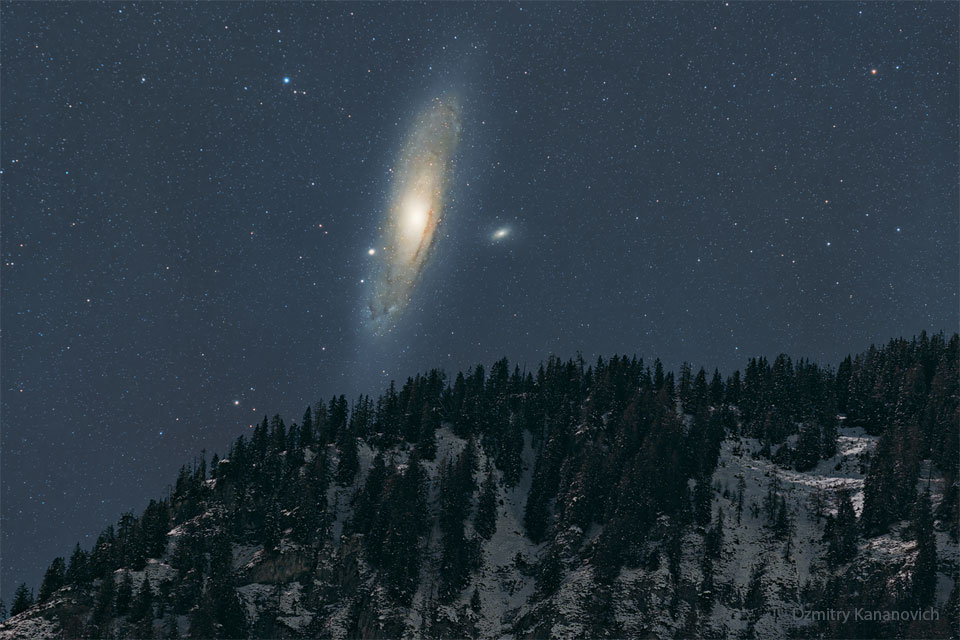
Dzmitry Kananovich
2023-11-13
Have you ever seen the Andromeda galaxy? Although M31 appears as a faint and fuzzy blob to the unaided eye, the light you see will be over two million years old, making it likely the oldest light you ever will see directly. The featured image captured Andromeda just before it set behind the Swiss Alps early last year. As cool as it may be to see this neighboring galaxy to our Milky Way with your own eyes, long duration camera exposures can pick up many faint and breathtaking details. The image is composite of foreground and background images taken consecutively with the same camera and from the same location. Recent data indicate that our Milky Way Galaxy will collide and coalesce with Andromeda galaxy in a few billion years. Follow APOD on Facebook in: Arabic, English, Catalan, Portuguese, or Taiwanese
